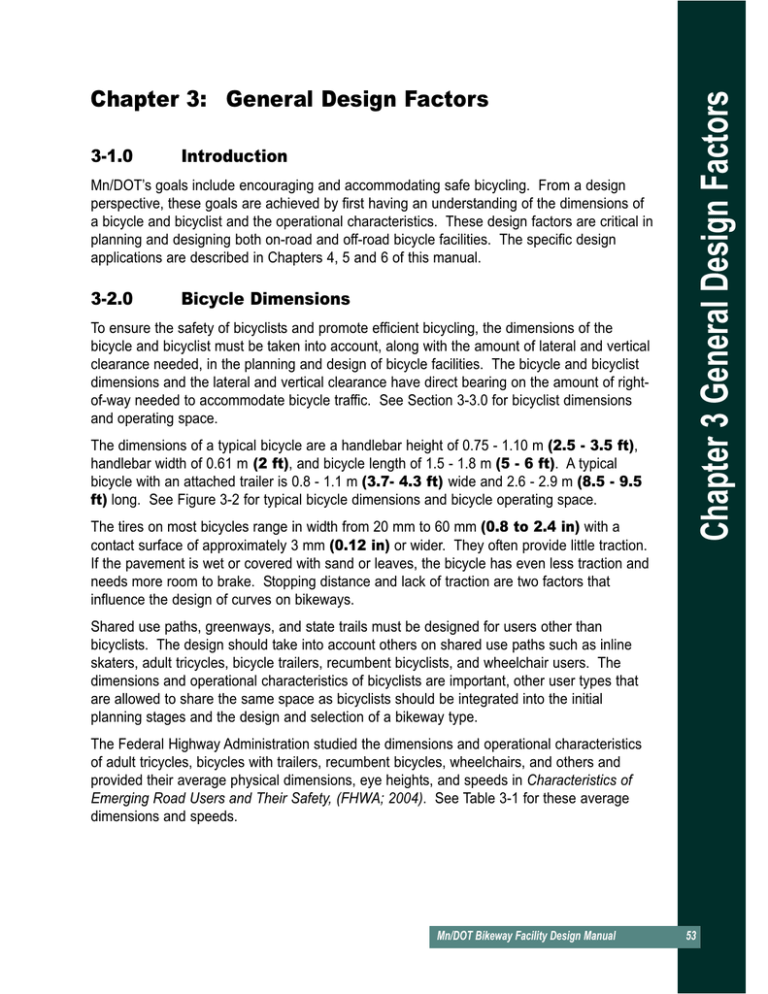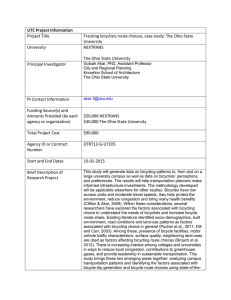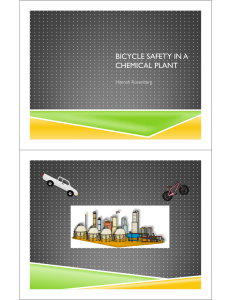Bikeway Facility Design Manual (Web): Chapter 3 General Design
advertisement

3-1.0 Chapter 3 General Design Factors Chapter 3: General Design Factors Introduction Mn/DOT’s goals include encouraging and accommodating safe bicycling. From a design perspective, these goals are achieved by first having an understanding of the dimensions of a bicycle and bicyclist and the operational characteristics. These design factors are critical in planning and designing both on-road and off-road bicycle facilities. The specific design applications are described in Chapters 4, 5 and 6 of this manual. 3-2.0 Bicycle Dimensions To ensure the safety of bicyclists and promote efficient bicycling, the dimensions of the bicycle and bicyclist must be taken into account, along with the amount of lateral and vertical clearance needed, in the planning and design of bicycle facilities. The bicycle and bicyclist dimensions and the lateral and vertical clearance have direct bearing on the amount of rightof-way needed to accommodate bicycle traffic. See Section 3-3.0 for bicyclist dimensions and operating space. The dimensions of a typical bicycle are a handlebar height of 0.75 - 1.10 m (2.5 - 3.5 ft), handlebar width of 0.61 m (2 ft), and bicycle length of 1.5 - 1.8 m (5 - 6 ft). A typical bicycle with an attached trailer is 0.8 - 1.1 m (3.7- 4.3 ft) wide and 2.6 - 2.9 m (8.5 - 9.5 ft) long. See Figure 3-2 for typical bicycle dimensions and bicycle operating space. The tires on most bicycles range in width from 20 mm to 60 mm (0.8 to 2.4 in) with a contact surface of approximately 3 mm (0.12 in) or wider. They often provide little traction. If the pavement is wet or covered with sand or leaves, the bicycle has even less traction and needs more room to brake. Stopping distance and lack of traction are two factors that influence the design of curves on bikeways. Shared use paths, greenways, and state trails must be designed for users other than bicyclists. The design should take into account others on shared use paths such as inline skaters, adult tricycles, bicycle trailers, recumbent bicyclists, and wheelchair users. The dimensions and operational characteristics of bicyclists are important, other user types that are allowed to share the same space as bicyclists should be integrated into the initial planning stages and the design and selection of a bikeway type. The Federal Highway Administration studied the dimensions and operational characteristics of adult tricycles, bicycles with trailers, recumbent bicycles, wheelchairs, and others and provided their average physical dimensions, eye heights, and speeds in Characteristics of Emerging Road Users and Their Safety, (FHWA; 2004). See Table 3-1 for these average dimensions and speeds. Mn/DOT Bikeway Facility Design Manual 53 54 Chapter 3: General Design Factors Table 3-1: Average dimension, eye height and speed of other user types Average Width m (ft) Average Length m (ft) Average Eye Height m (ft) Average Speed Km/h (mph) Bicycle 0.61 m (2.0 ft) 1.68 m (5.51 ft) 1.57 m (5.15 ft) 17 km/h (10.5 mph) Bicycle with trailer 0.80 m (3.7 ft) 2.90 m (9.50 ft) 1.60 m (5.25 ft) 17 km/h (10.5 mph) Hand cycle 0.65 m (2.1 ft) 1.81 m (5.94 ft) 0.96 m (3.15 ft) 14 km/h (8.7 mph) Inline skates 0.52 m (1.7 ft) 0.39 m (1.28 ft) 1.68 m (5.51 ft) 16 km/h (9.9 mph) Kick scooter 0.39 m (1.3 ft) 0.68 m (2.23 ft) 1.47 m (4.82 ft) 12 km/h (7.5 mph) Manual wheelchair 0.62 m (2.0 ft) 0.99 m (3.25 ft) 1.21 m (3.97 ft) 6 km/h (3.7 mph) Power scooter 0.58 m (1.9 ft) 1.12 m (3.67 ft) 1.32 m (4.33 ft) 9 km/h (5.6 mph) Power wheelchair 0.65 m (2.1 ft) 1.23 m (4.04 ft) 1.24 m (4.07 ft) 9 km/h (5.6 mph) Power wheelchair & dog 1.30 m (4.3 ft) 1.19 m (3.90 ft) 1.17 m (3.84 ft) 7 km/h (4.3 mph) Recumbent bicycle 0.62 m (2.0 ft) 1.90 m (6.23 ft) 1.26 m (4.13 ft) 23 km/h (14.3 mph) Segway5 0.64 m (2.1 ft) 0.56 m (1.84 ft) 1.88 m (6.17 ft) 15 km/h (9.3 mph) Skateboard 0.24 m (0.8 ft) 0.76 m (2.49 ft) 1.55 m (5.09 ft) 13 km/h (8.1 mph) Stroller 0.51 m (1.7 ft) 1.24 m (4.07 ft) 1.33 m (4.36 ft) 5 km/h (3.1 mph) User Type Mn/DOT Bikeway Facility Design Manual March 2007 Chapter 3: General Design Factors 3-3.0 55 Bicyclist Dimensions and Operating Space A bicyclist’s design vertical height is 2.4 m (8 ft). Although even a tall individual will not reach this height when seated on a bicycle, it is essential to allow extra clearance for bicyclists pedaling upright or passing under an overpass. Vertical clearance should be a minimum of 3 m (10 ft) to allow for the clearance of maintenance and emergency vehicles in underpasses and tunnels and to allow for overhead signing. Under normal conditions, a moving bicyclist needs a horizontal corridor at least 0.9 m (3 ft) wide in order to maintain balance when riding at low speeds or against crosswinds. To ride comfortably and avoid fixed objects (sidewalks, shrubs, potholes, signs signals, etc.) and other users such as pedestrians or in-line skaters, a bicyclist needs at least an additional 0.3 m (1 ft) of lateral clearance on each side, bringing the total operating width of a one-way corridor to 1.5 m (5 ft). If space is restricted, such as in a tunnel or bridge, a space at least 3 m (10 ft) wide is recommended for two opposing bicyclists to comfortably pass each other. See Figure 3-3 for bicycle operating space. More width may be needed to accommodate in-line skaters, bicycles with trailers, etc. Space is necessary for a bicyclist to react to unexpected maneuvers of another bicyclist or other user. Other users and their dimensions and operational characteristics should be considered in addition to typical bicyclists when designing facilities. See Table 3-1 for other user types and their average dimensions and speeds. Most bicyclists can maintain a cruising speed between 20 and 30 km/h (12 and 19 mph) and can maintain a speed of 30 km/h (19 mph) or better on flat terrain and windless conditions. In descents, with a tail wind, bicyclists can reach speeds more than 50 km/h (31 mph). Generally, bicyclists prefer routes without steep climbs. Bicycle facilities should be designed with the gentlest slopes practical to encourage the use of the bikeway. However, bikeway design and bicyclists’ behavior can be adjusted to compensate for steep terrain. Elevation changes may also appeal to some bicyclists. For a variety of reasons, motorists may not see bicyclists, especially after dark or in the rain or snow. Intersections and roadsides need adequate sightlines and lighting to help increase the visibility of bicyclists. March 2007 Figure 3-1: A bicyclist with a trailer has different dimensions and requires more operating space than a typical bicycle Mn/DOT Bikeway Facility Design Manual 56 Chapter 3: General Design Factors 400- 450 mm (16 - 18 in.) vertical clearance of handlebars 75 -100 mm (3 - 4 in.) 0.75 -1.10 m (2.5 - 3.5 ft) 250 mm (10 in.) 200 mm (8 in.) 1.5 - 1.8 m (5 - 6 ft) bicycle length 2.4 m (8 ft) Vertical clearance height 1.5 m (5 ft) Comfortable lateral clearance 0.9 m (3 ft) Essential maneuvering space 0.6 m (2 ft) Stationary bicyclist Side View Front View 0.8 -1.1 m (3.7 - 4.3 ft) stationary bicyclist with trailer 2.6 - 2.9 m (8.5 - 9.5 ft) bicycle with trailer length Front View Side View Figure 3-2: Typical bicycle dimensions and operating space Mn/DOT Bikeway Facility Design Manual March 2007 Chapter 3: General Design Factors 57 1.5 m (5 ft) Bicycle travel lane 1.5 m (5 ft) Bicycle travel lane 1.0 m (3.3 ft) 0.9 m (3 ft) Essential space Essential space 0.6 m (2 ft) 0.6 m (2 ft) Stationary bicycle Stationary bicycle 250 mm 250 mm (10 in.) (10 in.) 200 mm (8 in.) 0.6 m (2 ft) clearance post, curb & gutter, sidewalk or fence 1.5 m (5 ft) clearance 200 mm (8 in.) curb, gutter or roadway shoulder 0.9 m (3 ft) recommended space between two cyclists 3.0 m (10 ft) recommended path width for two-way bicycle travel Figure 3-3: Bicyclist operating space 3-4.0 Types of Bicyclists Bicyclists’ skills, confidence, and preferences vary significantly. Some bicyclists are comfortable riding anywhere they are legally allowed to operate, including space shared with motorized vehicles. Some bicyclists prefer to use roadways that provide space separated from motorists. Although children may be confident bicyclists and have some level of bicycle handling skills, they most often do not have the experience of adults nor the training or background in traffic laws necessary to operate safely on the road. Children need training in bicycle handling skills, education in traffic laws, and must use precaution in all traffic situations. See Chapter 2 for information about bicyclist education. Bicycle facilities should be planned to provide continuity and consistency for all types of bicyclists. The Federal Highway Administration developed the following general categories of bicyclist types to assist planners and designers in determining the impact of different facility types and roadway conditions on bicyclists. March 2007 Mn/DOT Bikeway Facility Design Manual 58 Chapter 3: General Design Factors Advanced Bicyclists Advanced bicyclists are experienced bicyclists who use their bicycle as they would a motor vehicle. They are biking for convenience and speed and want direct access to destinations with minimum detour or delay. They typically bike with motor vehicle traffic, biking on the roadway, but need sufficient operating space to eliminate the need for themselves or a passing motor vehicle to shift position. Basic Bicyclists Basic bicyclists are casual or new adult and teenage bicyclists who are less willing or able to operate in motor vehicle traffic without provisions such as bike lanes or paved shoulders or roads with lower speeds and motorized vehicle traffic volume. They prefer to avoid roads with higher speeds and motor vehicle traffic volumes unless there is ample roadway width to allow motor vehicles to pass. They prefer direct access to destinations using either low-speed, low trafficvolume streets, bike lanes, wide paved shoulders, or shared use paths. Children Children cicyclists are teenage or younger who bike on their own or with supervision. Their biking may be initially monitored by adults and are eventually allowed independent access to the road system. They still need access to key destinations surrounding residential areas, including schools, recreational facilities, shopping, or other recreational areas. Residential streets with low motor vehicle speeds, linked with shared use paths and streets with well-defined pavement markings between bicycles and motor vehicles can accommodate children. Children need supervision, a basic knowledge of traffic laws and bicycle operating skills before they can safely use on-road bikeways with higher motor vehicle volumes and speeds. Planners and designers need to take into account children’s lack of skill and experience when designing and planning transportation facilities. Bicycle and pedestrian accommodation on routes to schools, playgrounds, parks, libraries, and at high volume and complicated intersections is critical. Children do not have the experience or knowledge of traffic laws that adult bicyclists have. Children’s’ ability to perceive and respond to the road or path environment, and their ability to make quick decisions and perform multiple tasks may not be developed. A network of integrated on- and off-road bikeways with connections between the on- and off-road bikeways, are important to accommodate child bicyclists. The following list outlines some of the ways to accommodate all bicyclist types: ● Neighborhood and residential streets functioning at appropriate operating vehicle traffic speeds and volumes. ● Providing bike lanes on streets posted for lower speeds through the key travel corridors so that bicyclists can avoid higher volume, and/or higher speed roads. ● Providing paved shoulders on roads and highways, according to volumes and speeds of motor vehicle traffic as described in Chapter 4 of this manual. ● Providing shared-use paths in independent corridors. Mn/DOT Bikeway Facility Design Manual March 2007 Chapter 3: General Design Factors ● 59 Establishing and enforcing vehicle traffic speed limits to minimize speed differentials between bicycles and motor vehicles and by using traffic-calming strategies. Advanced bicyclists prefer roadways that accommodate shared use by bicycles and motor vehicles to minimize stopping and to maintain speed. This can be accomplished by: ● Providing bike lanes or wide outside lanes on collector and arterial streets with an urban cross section design (i.e., with curb). ● Providing paved shoulders on highways with a rural cross section design (i.e., without curb). ● Establishing and enforcing speed limits to minimize speed differentials between bicycles and motor vehicles and by using traffic-calming strategies. 3-5.0 Selecting the Bikeway Type A bicycle network plan as described in Chapter 2 helps to develop and promote a bikeway network with continuity and consistency and options for bicyclists with varying skills and experience. The desired outcome is to accommodate bicyclists, motorists, and other users with minimum travel delays to maximize safety, mobility and access. The selection of the bikeway suited for a travel corridor depends on many factors, including bicyclists’ abilities, corridor conditions, current and future land use, topography, population growth, roadway characteristics, and the cost to build and maintain the bikeway. Within any travel corridor, more than one option may be needed to serve all bicyclists. However, no one type of bikeway or road design suits every bicyclist. For basic bicyclists and children, key travel corridors Figure 3-4: should be identified through a An example of a bikeway type, a paved shoulder on a rural planning process, and bicycle highway accommodation should be provided through these corridors. However, roads and shared use paths that may not be on the bicycle network plan that link residential areas to schools, libraries, shopping areas, employment centers, parks, are also critical in serving basic bicyclists and children. Adopting design standards and guidelines that include wide curb lanes and paved shoulders to accommodate bicyclists help build the continuity of the bicycle network (see Figure 3-4). March 2007 Mn/DOT Bikeway Facility Design Manual 60 Chapter 3: General Design Factors 3-6.0 Bikeway Types Bikeways include both on-road and off-road facilities, including bike lanes, paved shoulders, shared lanes, wide outside lanes, and shared use paths. Bike lanes, paved shoulders, and wide outside lanes allow bicyclists and motorists to operate parallel to each other in the roadway, maintaining a separation, without requiring motorists to change lanes to pass bicyclists. There are many ways bicyclists can safely and conveniently be accommodated on roadways and other right-of-way. During the development of a transportation plan, planners and designers should recognize that the choice of road design will affect the level of bicycling, the types of bicyclists that will use the road, and the level of access and mobility that is provided to the bicyclist. Shared use paths and greenways offer opportunities not provided by the road system and can serve as direct commute routes. Shared use paths may also help to close gaps in the bicycle network caused by cul de sacs, railroads, freeways, and interstates or to navigate around natural barriers. Other users that are allowed to use shared use paths should be integrated into the design as well. The overriding goals in selecting and designing a bikeway type are: ● The bikeway allows for bicyclists to operate in a manner that is consistent with traffic laws. ● The needs of motorists, pedestrians, and bicyclists are integrated in the design of the bikeway. ● Road crossings and connections are provided that provide access to other bikeways. The design and applications of on-road bikeways, including shoulders, bike lanes, shared lanes and wide outside lanes, are described in Chapter 4 of this manual. The design and applications of off-road bikeways, including shared-used paths are described in Chapter 5. 3-7.0 Accessible Design Most bicycle facilities are required to comply with Americans with Disabilities Act of 1990 (ADA) so that they are functional for all users, both with and without disabilities. ADA is a law that protects the civil rights of persons with disabilities. It prohibits discrimination on the basis of disability in employment, State and local government services, transportation, public accommodations, commercial facilities, and telecommunications. Transportation facilities such as paths and sidewalks and bicycle facilities shared with pedestrians shall comply with existing ADA standards (ADA Accessibility Guidelines for Buildings and Facilities (ADAAG)) and use the pending design guidelines for public rights-of-way that will be incorporated into ADAAG as best practices. All new construction that has bicycle and/or pedestrian facilities must incorporate accessible pedestrian features to the extent technically feasible, without regard to cost. Mn/DOT Bikeway Facility Design Manual March 2007 Chapter 3: General Design Factors 61 To optimize design for persons with disabilities, planners and designers must address surface cross slope, surface material treatment, minimum path width, maximum running slope of 5%, curb ramp locations and design, and other elements that may create localized obstructions affecting use. Removal of all accessibility barriers will maximize opportunities for the largest number of people. The Access Board, the federal body responsible for drafting accessibility guidelines is working to supplement those guidelines that the Access Board has issued for the built environment and will address unique constraints specific to public rights-of-way. When finalized, they will become a part of the ADAAG. The provisions being developed include surface treatment, minimum path width, passing space, and changes in the level surface. March 2007 Mn/DOT Bikeway Facility Design Manual



